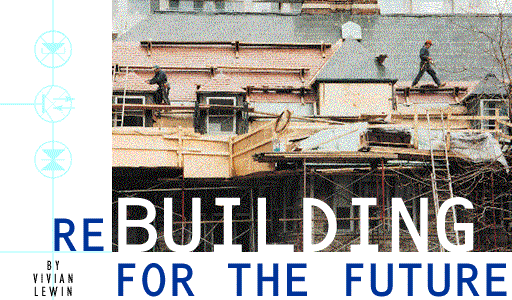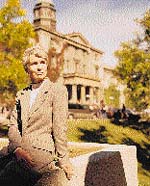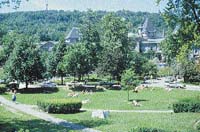
McGill is quick to laud the achievements of its graduates and the stellar qualities of its professors. But the campus itself can be a significant part of the McGill experience. Those physical settings -- a green island in downtown Montreal, a dozen venerable houses in the old Square Mile, and a broad cluster of fields and buildings in Ste-Anne-de-Bellevue -- leave a strong impression on the visitor and loom large in the memory of every graduate.
New and old, McGill's buildings comprise a unique architectural treasure. "Very few urban campuses are as coherent as McGill's," observes Julia Gersovitz, BArch'75, who teaches in the School of Architecture at McGill and whose firm specializes in the restoration of historic buildings.

Lawrence Dobby remembers long hours at the Macdonald Engineering Building.
Photo: Owen Egan
Top: Martlet House, home to the Alumni Association and a heritage property, gets a roof re-fit in 1994. .
Photo: Mary Lynn Fiske
|
"Princeton and Yale grew up at the same time as their cities grew; they don't have that sense of being islands in extremely dense urban centres. The closest analogy might be Columbia, because of the density of the urban fabric around the college, yet the buildings themselves are all crowded together with very little natural landscape left. McGill, while it is old and surrounded by the city, preserves 'the still and quiet air of delightful studies'," Gersovitz says, quoting a phrase carved on the outside wall of the Redpath Library.
Gael Eakin, BA'61, a member of McGill's Board of Governors, says the question of encroaching on the lower campus green space has come before the Board repeatedly over the years. "They could have put new McGill buildings on the land facing Sherbrooke, but they wanted to leave the campus open to the city, keep it from getting closed in on itself. That was a decision they had to make over and over again."
For Lawrence Dobby, BEng'73, a trip downtown to visit the campus brings back memories of studies which, if not delightful, were certainly intense. "I like the old buildings," says Dobby as we stand at the entrance to the five-storey Macdonald Engineering Building, built in 1909 at the edge of the lower campus. "Look at these oak doors. Made to last -- and they have, too. This is where I came every morning on the 7:30 train...
I kept a strict schedule. On Saturdays I came to the library and studied from 9 to 4." On the day we meet, workmen are restoring the original lobby and installing an overhead sprinkler system in the building, which last saw major renovations in 1926.

McGill Governor Gael Eakin finds a place in the sun near the Arts Building.
Photo: Claudio Calligaris
|
"The oldest buildings are extraordinarily well built," says Gersovitz. "I'm talking about those constructed from the middle of the 19th century up to the First World War. Even though they have taken an amazing beating, they have been holding up. But their time is coming."
According to a report from the University's Office of Physical Resources, McGill has 33 buildings -- 6 at Macdonald and 27 on the downtown campus -- which qualify as heritage properties and therefore require special treatment. They also present special problems. For example, any exterior improvements require extra approvals -- first from McGill's Architectural Advisory Sub-Committee and then from the Comité consultatif de Montréal sur les biens culturels, a municipal agency responsible for preserving the city's heritage.
"We can't afford to maintain these buildings, and we can't afford to replace them," says Chuck Adler, BEng'71, MUP'74, Director of the University Planning Office. It's Adler's job to ensure that, based on academic needs, adequate and properly equipped physical facilities are available.
"Any repairs on these buildings have to be done properly. You have to use the proper material, which can be very expensive. You can't slap an asphalt roof onto the Redpath Museum or go to Réno-Dépôt and get a new balcony."
Adler says last winter's ice storm "accelerated the collapse of aging roofs that were weak already. Water just poured in the middle of Wilson Hall, ruining one of the rooms."

Luc Joli-Coeur "in the flow of action" on the Redpath Museum steps.
Photo: Owen Egan
|
It also led to a supply-and-demand problem. "If other people in town are replacing heritage roofs, the cost goes up. There are only so many companies equipped to do it. And especially in older buildings, estimates don't mean much. Until you open it up, you don't know what you might need."
It isn't just heritage properties that need work. "We talk about masonry and roofs," says Radu Juster, McGill's capital alterations manager, "but the main cost is replacing mechanical and electrical systems. One reason the heritage buildings have lasted this long is because they don't have as many moving parts. The buildings McGill put up in the 1960s and '70s are coming to the end of their natural life cycle."
Burnside Hall is a relatively new (1969) 12-storey tower on the southeast corner of the main campus close to the Roddick Gates. Surrounding the building are wide concrete terraces which cover classrooms and some of the University's computing facilities located in the basement. Those ceilings have been leaking for years. "We had actually built waterways to carry the water away from the computers," Adler says. "The computing centre houses Quebec's major gateway to the Web -- and also does our payroll!" Juster adds.
This summer the Burnside terrace and two others covering parts of the Leacock Building and the McLennan Library were replaced. In fact, the yellow tape marking off construction zones blossomed all over campus as work was carried out on the most urgent projects. "We spent $22.4 million -- including a $14 million capital grant from Quebec," says Adler.
What's next? "We have a long list," he says. "We entered 1998 with about $180 million of work looming over our heads. When you talk about the outer shell -- roofs, windows, masonry -- it's all connected. And we look at safety. On the Macdonald campus, the buildings are not in bad shape. There, we need road work and a new emergency water system."
The big job this year, according to Adler, is the McIntyre Medical Building, the circular 16-storey landmark on Pine Avenue, built in 1967. Water problems there had become critical. "The researchers couldn't do their research. The rain was pouring onto their bench tops. Now we're redoing the whole 'skin' of the building."
But McGill has no reserve funds set aside for plant renewal. Quebec's regular annual capital grants -- money doled out for repairs and new equipment and based on a formula applied evenly to all universities -- are admittedly only about half what the province calculates is needed. Last year, McGill received about $11 million, and the University administration worries about the ballooning budget item known as "deferred maintenance."
So does Gersovitz. "I'm very sympathetic to the managers who have been given very few resources to work with. But deferred maintenance is an oxymoron. Maintenance means 'ongoing,' while deferred means 'not happening.' An endowment for these buildings is obviously part of the solution."

A view of the cherished green space of lower campus looking from east to west.
|
And it's also part of the University's plans. The new McGill Heritage Fund has been established to provide support for maintenance and renovation. Projects will be selected based on priorities identified in the University's annual surveys of needed repairs.
In Gael Eakin's time, many of the buildings now causing problems hadn't been built. The campus itself was more compact. "We went from the Arts building to the Student Union [now the McCord Museum] and from the Arts building to the library. All the large first-year classes were in Moyse Hall -- the only room big enough to hold us. I had biology in what is now the Administration Building and zoology in that nice old hall in the Redpath Museum. Between every class we would come out and stand in front of the Arts Building, hopefully in the sun. That's where you might get your date for Saturday night."
McGill's students were drawn mainly from the Montreal area, Eakin says, and life centred around activities on campus. "We went to McGill because our parents said so -- it was expected. We were the last of the generations that did that. We all lived at home so we tried to spend the whole day here."
Sitting on the steps of the Redpath Museum -- one of his favourite spots at McGill -- Luc Joli-Coeur, BA'87, MUP'90, analyzes the importance of the campus to his more recent experience as a student.
"When I arrived at McGill I didn't know anybody. I studied at Brébeuf and all my classmates went on to Université de Montréal. I got to know people through activities like the ski club and McGill Daily Français. I think the campus helped people get involved. It's easier to organize these things because of the indoor/outdoor space. In Leacock, for instance, the hallway space is also a meeting space. When you go to the McLennan Library, you want to sit on the terrace. There are lots of places to hang out, read your notes, and if somebody you know comes by you can talk."
"UQAM [Université du Québec à Montréal] has a whole lot of daytime students, but the way the university is organized, it's hard to meet people because there's no place to sit around and see people walk by. These spots have to be in the flow of action. I bet a couple of hundred people have walked by just while we've been sitting here."
Adds Joli-Coeur, "That's part of McGill -- also part of what a university is -- students exchanging what they know. Education isn't just from professor to student. You have to preserve the basic fabric of the semi-public spaces where people can meet, sit around -- just enjoy life on campus."
Vivian Lewin is a Communications Officer for Development and Alumni Relations.
|